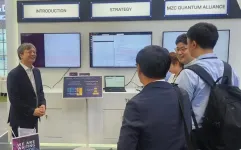(Press-News.org) Artificial intelligence can help people process and comprehend large amounts of data with precision, but the modern image recognition platforms and computer vision models that are built into AI frequently overlook an important back-end feature called the alpha channel, which controls the transparency of images, according to a new study.
Researchers at The University of Texas at San Antonio (UTSA) developed a proprietary attack called AlphaDog to study how hackers can exploit this oversight. Their findings are described in a paper written by Guenevere Chen, an assistant professor in the UTSA Department of Electrical and Computer Engineering, and her former doctoral student, Qi Xia ’24, and published by the Network and Distributed System Security Symposium 2025.
In the paper, the UTSA researchers describe the technology gap and offer recommendations to mitigate this type of cyber threat.
“We have two targets. One is a human victim, and one is AI,” Chen explained.
To assess the vulnerability, the researchers identified and exploited an alpha channel attack on images by developing AlphaDog. The attack simulator causes humans to see images differently than machines. It works by manipulating the transparency of images.
The researchers generated 6,500 AlphaDog attack images and tested them across 100 AI models, including 80 open-source systems and 20 cloud-based AI platforms like ChatGPT.
They found that AlphaDog excels at targeting grayscale regions within an image, enabling attackers to compromise the integrity of purely grayscale images and colored images containing grayscale regions.
The researchers tested images in a variety of everyday scenarios.
They found gaps in AI that pose a significant risk to road safety. Using AlphaDog, for example, they could manipulate the grayscale elements of road signs, which could potentially mislead autonomous vehicles.
Likewise, they found they could alter grayscale images like X-rays, MRIs and CT scans, potentially creating a serious threat that could lead to misdiagnoses in the realm of telehealth and medical imaging. This could also endanger patient safety and open the door to fraud, such as manipulating insurance claims by altering X-ray results that show a normal leg as a broken leg.
They also found a way to alter images of people. By targeting the alpha channel, the UTSA researchers could disrupt facial recognition systems.
AlphaDog works by leveraging the differences in how AI and humans process image transparency. Computer vision models typically process red, green, blue and alpha (RGBA) images—values defining the opacity of a color. The alpha channel indicates how opaque each pixel is and allows an image to be combined with a background image, producing a compositite image that has the appearance of transparency.
However, using AlphaDog, the researchers found that the AI models they tested do not read all four RGBA channels; instead they only read data from the RGB channels.
“AI is created by humans, and the people who wrote the code focused on RGB but left the alpha channel out. In other words, they wrote code for AI models to read image files without the alpha channel,” said Chen. “That’s the vulnerability. The exclusion of the alpha channel in these platorms leads to data poisoning.”
She added, “AI is important. It’s changing our world, and we have so many concerns.”
Chen and Xia are working with several key stakeholders, including Google, Amazon and Microsoft, to mitigate the vulnerability regarding AlphaDog’s ability compromise systems.
END
Researchers at The University of Texas at San Antonio reveal oversight in AI image recognition tools
2024-10-14
ELSE PRESS RELEASES FROM THIS DATE:
World of crayfish™: A web platform for global mapping of freshwater crayfish and pathogens
2024-10-14
Freshwater crayfish, keystone species of aquatic ecosystems, are now at the center of a new tool that promises to revolutionize conservation efforts. World of Crayfish™ (WoC), a newly launched web platform, aims to provide real-time global mapping of freshwater crayfish and their pathogens, offering an invaluable resource for researchers, conservationists, and environmental stakeholders.
Published in PeerJ Life and Environment, the article, World of Crayfish™: A web platform towards real-time global mapping of freshwater crayfish and their pathogens, highlights the urgent need for accurate, up-to-date data on ...
How to make biodiversity credits work: science-based solutions for real conservation gains
2024-10-14
Biodiversity is in crisis. Human activities are driving species extinctions at unprecedented rates, but funding for conservation remains woefully inadequate. To address this gap, the concept of a Biodiversity Credit Market (BCM) has emerged, inspired by carbon credit systems that incentivize conservation and restoration efforts.
However, while the BCM holds promise, it risks falling into the same pitfalls as its carbon counterpart—especially if it fails to implement rigorous science-backed baselines, ...
Qunova becomes first to achieve ‘chemical accuracy’ on commercial quantum computers with its hardware agnostic algorithm
2024-10-14
DAEJEON, South Korea (October 14, 2024) – Qunova Computing, a developer of quantum software applications designed to bring quantum computing to the chemical, pharmaceutical and industrial engineering industries, today announces the results from a series of recent tests performed on three different NISQ era quantum computers, each with a different qubit count. In each demonstration, Qunova’s algorithm was able to produce results with accuracy below the threshold of 1.6 millihartrees required for real-world quantum chemistry applications, a level known as ‘chemical ...
Scientists have successfully bred corals to improve their heat tolerance
2024-10-14
Scientists have successfully bred corals to improve their heat tolerance
A new study has shown that selective breeding can lead to a modest rise in coral heat tolerance.
Led by experts at Newcastle University’s Coralassist Lab, the study documents the world’s first effort to selectively breed adult corals for enhanced heat tolerance, i.e. the ability of adult corals to survive intense marine heatwaves. The breeding effort was a success, showing that it is possible to improve the heat tolerance of adult coral offspring, even in a single generation.
However, the improvement was modest in comparison ...
Adaptability of trees persists after millions of years of climate change
2024-10-14
Seven of the most common forest trees in Europe have been shown to be able to shelter their genetic diversity from major shifts in environmental conditions. This is despite their ranges having shrunk and the number of trees having fallen sharply during ice age cycles. These are the findings of a study by a European consortium including Uppsala University, published in Nature Communications.
“From a biodiversity perspective, this is very positive because these trees are keystone species on which many other species depend,” says Pascal Milesi, Associate Professor of Plant Ecology and Evolution at Uppsala University and first author of the study.
The researchers aimed to investigate ...
Protein involved in balancing DNA replication and restarting found
2024-10-14
A protein that is involved in determining which enzymes cut or unwind DNA during the replication process has been identified in a new study.
In a new paper published in Nature Communications, an international team of researchers have found that the protein USP50 supports the DNA replication process by helping to decide the proper use of nucleases or helicases. These enzymes are implemented during the DNA replication process to promote ongoing replication and where the copying machinery runs into problems ...
How liberals and conservatives can have better conversations, according to a psychologist
2024-10-14
Bridging Our Political Divide collects the insights of a psychologist who offers antidotes to the unproductive arguments that now dominate our political culture and ways to find common ground.
New York, U.S./Oxford, UK, October 14, 2024 – As the 2024 US Presidential Election in November inches closer, the partisan divide in American society has never felt more apparent – or pervasive.
From workplace chatter to heated discussions at family gatherings, many Americans may have asked themselves, ‘How can I make this ...
Survey finds 25% of adults suspect they have undiagnosed ADHD
2024-10-14
COLUMBUS, Ohio – Attention deficit/hyperactivity disorder – also known as ADHD – is typically thought of as a childhood condition. But more adults are realizing that their struggles with attention, focus and restlessness could in fact be undiagnosed ADHD, thanks in large part to trending social media videos racking up millions of views.
A new national survey of 1,000 American adults commissioned by The Ohio State University Wexner Medical Center and College of Medicine finds that 25% of adults now suspect they may have undiagnosed ADHD. But what worries mental health experts is that only 13% of survey respondents have shared their suspicions with their doctor.
That’s ...
Let there be light: Bright future for solar panels, TV screens and more
2024-10-14
From brighter TV screens to better medical diagnostics and more efficient solar panels, new Curtin-led research has discovered how to make more molecules stick to the surface of tiny nanocrystals, in a breakthrough that could lead to improvements in everyday technology.
Lead author Associate Professor Guohua Jia from Curtin’s School of Molecular and Life Sciences, said the study investigated how the shape of zinc sulfide nanocrystals affected how well molecules, known as ligands, stick to their surface.
“Ligands, play an important role in controlling the behaviour and performance ...
Innovative nanoparticle therapy targets fat absorption to combat obesity
2024-10-13
(Monday 14 October 2024, Vienna, Austria) Researchers have unveiled a novel approach to tackle obesity by targeting fat absorption in the small intestine. The cutting-edge nanoparticle system, engineered to deliver therapeutic molecules directly to the digestive tract, has shown significant potential to prevent diet-induced obesity.1,2
Presented today at UEG Week 2024, the study focuses on an enzyme called Sterol O-acyltransferase 2 (SOAT2), which plays a critical role in fat absorpsion in the small intestine.3,4 By inhibiting this enzyme in the small intestine, the study offers a promising therapeutic approach to reduce fat absorption ...





